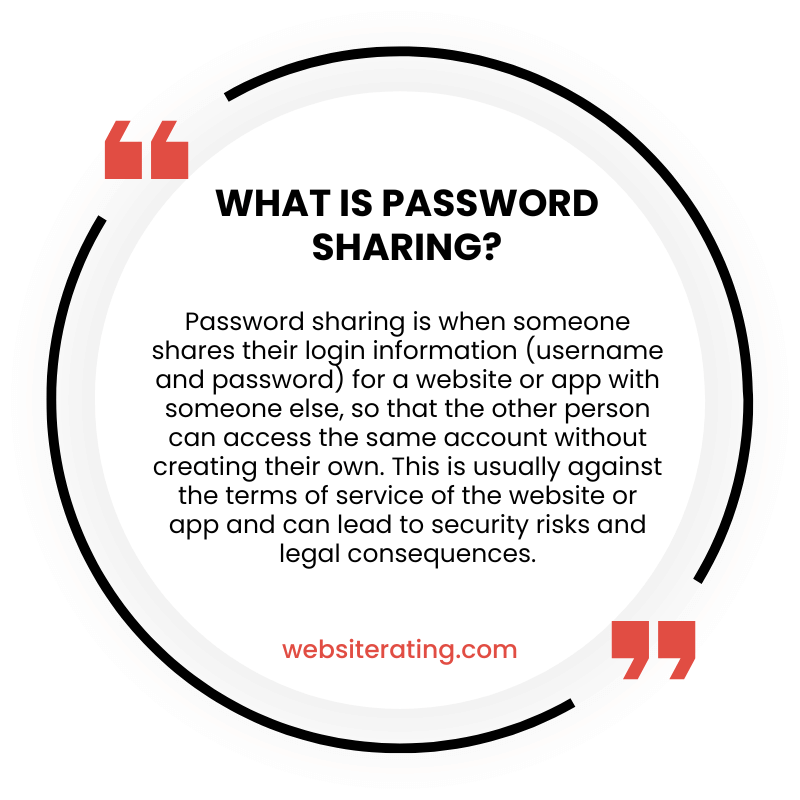Password sharing is an increasingly common practice among users of online services and websites. It involves allowing multiple people to access the same account using the same login credentials, such as username and password. This allows multiple users to access a single account without needing to create separate accounts for each user.

In this article, we will discuss what password sharing is, provide examples of how it can be used, and look at some of the pros and cons associated with it.
What is Password Sharing?
The sharing of confidential access details among multiple users has become an increasingly popular practice in our digital world. Password sharing refers to the practice of granting multiple users access to a service or account by using a single username and password.
This strategy is used to allow multiple people to use the same online accounts without needing to remember separate login credentials for each user. This technique can be particularly useful for family members who need access to different services, such as streaming sites or shopping websites.
It is also commonly used in workplaces where multiple employees need access to various accounts and systems, but only one administrator needs to manage the passwords. Password sharing can save time and money, but it can also increase security risks if not done correctly.
To ensure safety, best practices include frequent password changes and strong password requirements that are unique for each user.
Examples of Password Sharing
Partaking in a secure exchange of login credentials between two or more parties is commonly referred to as password sharing. Password sharing is an increasingly popular practice that can be seen across a variety of different contexts, such as work environments and online gaming.
For example, in the workplace, colleagues may need to access shared accounts and documents, so they must share passwords with each other securely. In the context of online gaming, some players might participate in guilds where they collaborate on missions together – for this reason, players will often share their account information with each other.
Password sharing should always be done using reliable security measures such as encrypted messages or password managers (e.g., LastPass). This helps ensure that the login credentials remain safe from malicious actors who may want to gain access to sensitive accounts and information.
Moreover, it’s important for users to create strong passwords when engaging in password sharing and change them regularly for added security.
Pros and Cons of Password Sharing
Engaging in password sharing offers both advantages and drawbacks that should be carefully considered.
On one hand, sharing passwords can create a convenient way to access accounts without having to remember multiple usernames and passwords. This can be especially helpful in the workplace, where multiple people may need access to the same account information. Furthermore, it can also help reduce the risk of lost or forgotten passwords that might otherwise require costly security measures to reset them.
On the other hand, password sharing can present certain risks as well. For example, if someone with access to shared passwords leaves an organization or has their credentials revoked for some reason, there is no guarantee they will not continue using those credentials elsewhere. Additionally, if a malicious user gains access to shared accounts, it could lead to significant damage that would be difficult and expensive to repair.
Therefore it is important for organizations who engage in password sharing practices to have clear policies regarding how these shared accounts are managed and monitored on an ongoing basis.
Summary
Password sharing is a useful tool for individuals and organizations to securely store and manage passwords. It provides an efficient method of organizing accounts, as well as the ability to share access with multiple users.
With proper security measures in place, password sharing can be an effective way to ensure that all of one’s passwords are kept secure without compromising privacy or data integrity. Despite its benefits, it is important to consider the potential risks associated with password sharing when deciding whether or not it is right for you.
Ultimately, the decision should be based on an individual’s specific needs and security requirements, but knowing what options are available can help make this decision easier.
More reading
Password sharing refers to the act of sharing login credentials with other people so they can also have access to your account. It can be necessary for people to share passwords with friends, family, and colleagues, but there is a right and wrong way to do it. Unsafely sharing passwords can place your streaming and online accounts at risk. The best way to manage passwords, including managing the sharing of passwords, is with a password manager (source: PCMag, Dashlane, Keeper Security).
